|
|
|
|
Falsifications on Khojaly issue. In recent years, the Armenian online media has been passing photos of
Azerbaijani people slaughtered at Khodjaly for the murdered Armenians. Some of them are given below.
But due to the lack of evidence to prove the "massacre", the Armenian side passes photos of killed Azerbaijanis for Armenians. This is one of many examples of such forgeries, using the photos of Azerbaijanis, namely Khodjaly residents to present them as Armenians. On the picture there are Azerbaijani refugees who reached Agdam on foot and militiamen trying to help them. There are photos of exactly these women taken at the same place by a French photographer Frederique Lengaigne: Other photos by Frederique Lengaigne [click here] _________________________
An Armenian English-speaking website www.asbarez.com doesn’t disdain to use
such forgeries, either. _________________________ Xocali.net In 2010, the Armenian mass media reported to have designed www.xocali.net
website. According to their reports, it was created in order to “Tell the truth
about Khodjaly”. This website is the product of the official propaganda of Armenia. Let’s have a look at the contents of the site and the essence of arguments of the Armenian side in 2010. The most “lurid” and “sensational” section of the site is named “Facts. Forgeries & Falsifications.” This chapter exactly contains, as the website designers believe, the compelling evidence of the Armenian “truth” about Khodjaly. There is a statement given on the front-page backed up by nothing: Obviously, this sentence alone contains two figments: 1 – The shooting area was the only place where the Khodjaly residents were found killed. 2 – The location was controlled by Azerbaijanis. No references given- it is a “generally accepted fact”; the audience is believed to have no idea of the events without any desire to check the information provided. Thus, only few dozens of the corpses out of more than 600 victims of the Khodjaly massacre were found on the area filmed. That’s evident from the pictures shot, and the report by “Memorial” human rights group, as well. The bodies discovered at the footage area belonged to those who had managed to escape the carnage by Nakhichevanik and break through to Agdam but overtaken by Armenians in few miles from the destination town. “The “NKR” officials reported the “Memorial” activists that “they gave a permission to take out near 120-130 corpses to Agdam”. A part of the dead was seriously wounded upon reaching Agdam but unable to be
cured by doctors. The second figment about the video shooting being controlled by the Azerbaijani side can be easily disproved, too. At the moment, the Armenian troops exercised control of Askeran 5-6
kilometres away from Khodjaly. The Azerbaijani forces controlled Agdam within 10
kilometres from Askeran. Thus, a shooting area was located approximately in the
middle, between Askeran and Agdam. The first attempt to land failed exactly because of the shelling. Human Rights Watch also testifies the fire: These two coinages that the website creators tried to “invent” obscurely – the sole place of the Khodjaly residents’ slaughter and the territory being controlled by Azerbaijanis – play a significant role in their subsequent “reasoning”. Let’s return to the site. It writes: This sentence could imply the Armenian side to examine the true documentary
database,such as the reports by Human Rights Watch and “Memorial”, testimonies
of the correspondents of a London “The Times” , an American “The Washington
Post”, a Russian “Izvestiya”, and a number of other editions. It could be
expected that all the photo- and video footage would be studied properly and the
audience would be offered to read the published memoirs by Monte Melkonyan*’s
wife and brother. “Let’s depart from standard references to “pro” and “contra” resources this
time and rely on the factual materials, namely: photos and video footage.” Secondly, since when the witnesses’ testimony were discarded as a factual material? Moreover, the testimony of the independent journalists and human rights activists. Do the website creators perceive the notion of the word “factual”? Unfortunately, these questions still remain unanswered. A very strange thing- it turns out that if we take a dozen of photos not
relating to the Holocaust, and scatter them in the world wide web in the guise
of the Holocaust, we can easily create a website proving that there was either
no Holocaust, or it was the Jews to have killed the Jews in Germany. Only one photo out of seven was taken from the Azerbaijani mass media website.
In spite of resorting to the official resources and documents, the Armenian side decided to use the World Wide Web, namely blogs and forums, hoping to fish out the information that can only show an obvious laziness of the Internet users, bloggers, and web-masters that did not use the materials published on the official Azerbaijani documents.
The real pictures of the Khodjaly tragedy are much more dramatic and terrifying.
The rest of pictures relate directly to the genocide of Azerbaijanis committed
by the Armenian government. In the Azerbaijani documentaries (and the official websites, as well), these photos like many others including those of Khodjaly victims, are put in the general database, testifying the genocide of Azerbaijanis. Of course, very often those who weren’t let into the pages of the horrible tragedy of the Azerbaijani people of 1987-1994, can guess all the photos to be related to Khodjaly. And Azerbaijani experts’s task is to give an explanation that Khodjaly was just one of a great number of cases when Azerbaijanis were victims of the Armenian militants and terrorists. Finally, the following 5 pictures that regard the real documentary base of
the Khodjaly tragedy. There were presented the first and second video footage by Chingiz Mustafayev with a difference of 2 days. The website authors attempt to prove that several bodies “turned out to” be disfigured and scalped within that period of time. An uninformed reader, who has never seen the footage, may conclude that Armenians revealed a “thoroughly hidden fact”. The Azerbaijani side, however, constantly reminds this fact; Chingiz Mustafayev himself reported that in the video spread all over the world. Besides, the website owners fail to mention that there were scalped bodies detected during the very first flight, too, straight after the tragic events. Human Rights Watch reports the rescue team and a French correspondent found the scalped and mutilated corpses at the first flight of Chingiz Mustafayev at the scene of the tragedy. According to the report by “Memorial”, there was even a case of scalping a
living person recorded. Naturally, an average man can hardly imagine how people could scalp living men, mutilate the dead bodies, and furthermore, return to the carnage area to get more scalps and other “prizes” in the late 1990s. However, Markar and Seta Melkonyan give us a much more visual representation of the morals reigning among Armenian “heroes”: «In November 1990, Kechel had kidnapped a young Azerbaijani Popular Front activist from a village across the border. The young Azeri, Syed, spent a month chained to the wall of a cottage near Yerevan. On New Year’s Eve 1991, Kechel and a couple of buddies, including a local police officer and their friend Ardag, dragged their captive to the top of Yeraplur, the burial hill near Yerevan. There they kicked Syed to his knees under a spreading tree next to the grave of a fellow fighter named Haroot. Then Kechel, a father of three children, began cutting Syed’s throat with a dull knife. At first Syed screamed, but after a while the screaming gave way to moaning and gurgling. Finally, when Ardag could no longer listen, he pushed a knife into Syed’s chest, putting an end to it. They drained Syed’s blood on top of Haroot’s grave and then left.”
The Azerbaijani side tried to take out the girl’s body during the first flight, but was prevented by the shelling. Armenians endeavor to expose the blanket pulled off (to demonstrate the wound) as an attempt of Azerbaijanis to charge them with the rape of a 3-year old girl. But there were none either in press or in the official messages. The photos of decayed bodies bought out a long time later from the Armenian side, are presented as evidence of Azerbaijanis exhuming the corpses to prove the killings. The Armenian reasoning is remarkably plain and similar. A few dozens of
pictures and video footage shattering their arguments has not been shown to the
audience, of course. For instance, we can see the following “fact” in the section “Azerbaijani
evidence”: Obviously, the website authors were so carried away by forgeries to forget that Lala Gadjiyeva arrived in Azerbaijan in 1993 and was appointed the Secretary of State in June 1993. Therefore, she could not make any speech in front of Azerbaijani soldiers in
1992. *A book by Monte Melkonyan’s brother Markar Melkonyan and widow Seta Melkonyan “My Brother's Road: An American's Fateful Journey to Armenia”. |
| Copyright © 2012 All rights reserved | |

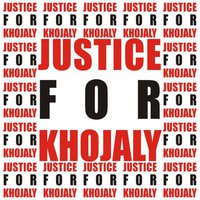
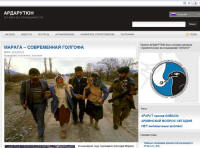
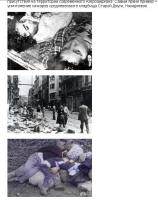
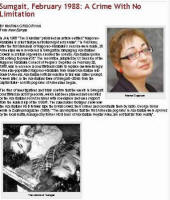
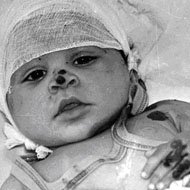
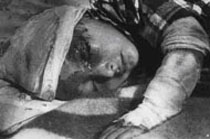 ОIt’s
difficult to judge the source of this photo and the way it got on the
Azerbaijani online editions. It could be explained, perhaps, by the similarity
with the pictures and video footage taken at the scene of massacre at Khodjaly,
like the one given below.
ОIt’s
difficult to judge the source of this photo and the way it got on the
Azerbaijani online editions. It could be explained, perhaps, by the similarity
with the pictures and video footage taken at the scene of massacre at Khodjaly,
like the one given below.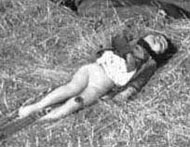 There
were also some thoughts posted on www.xocali.net about the picture of a killed
girl. By presenting the black and white picture highly contrasted, the creators
of the website are trying to prove that a wound on the girl’s leg was inflicted
later, as there was no bruise seen, though it was easily revealed on the less
contrasted shots.
There
were also some thoughts posted on www.xocali.net about the picture of a killed
girl. By presenting the black and white picture highly contrasted, the creators
of the website are trying to prove that a wound on the girl’s leg was inflicted
later, as there was no bruise seen, though it was easily revealed on the less
contrasted shots.